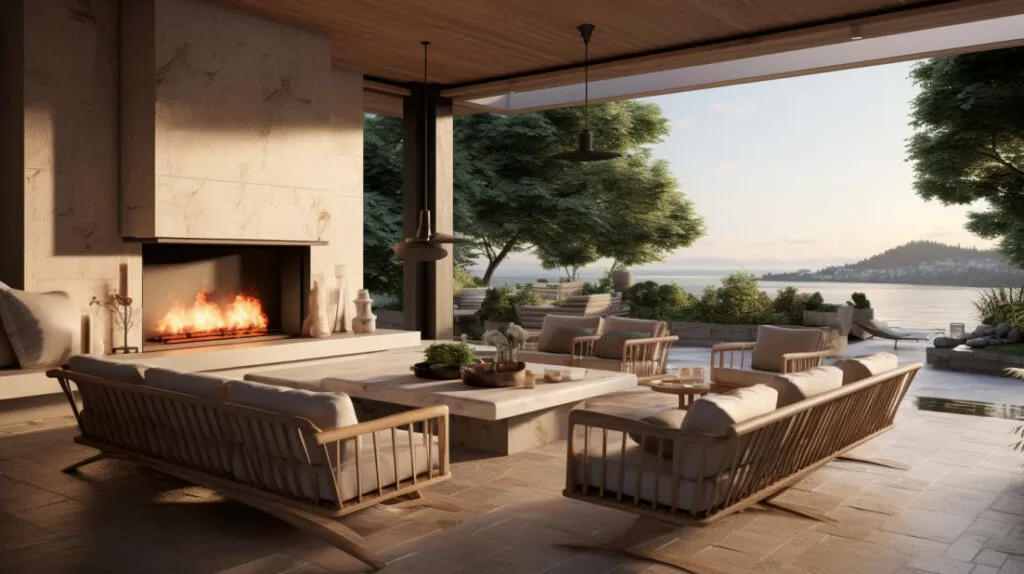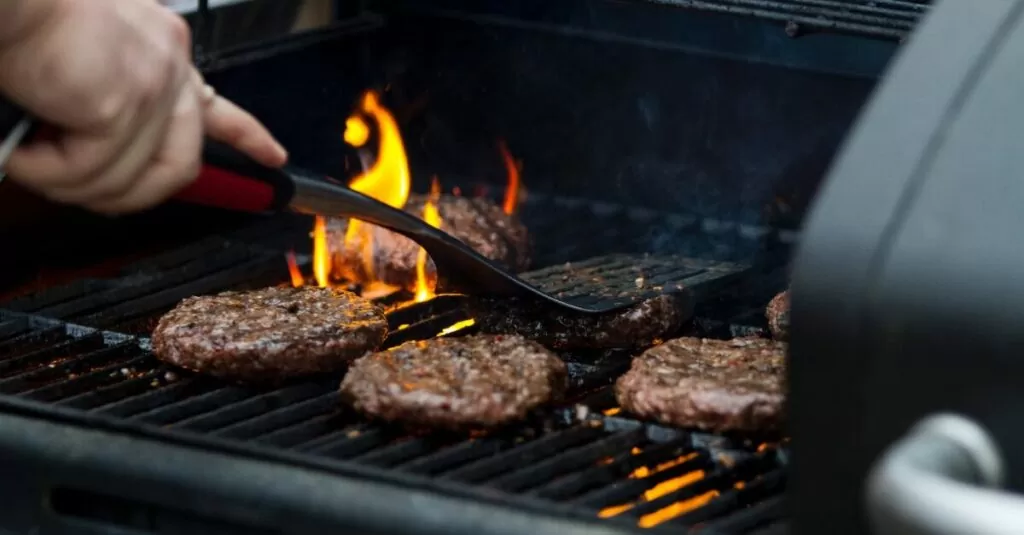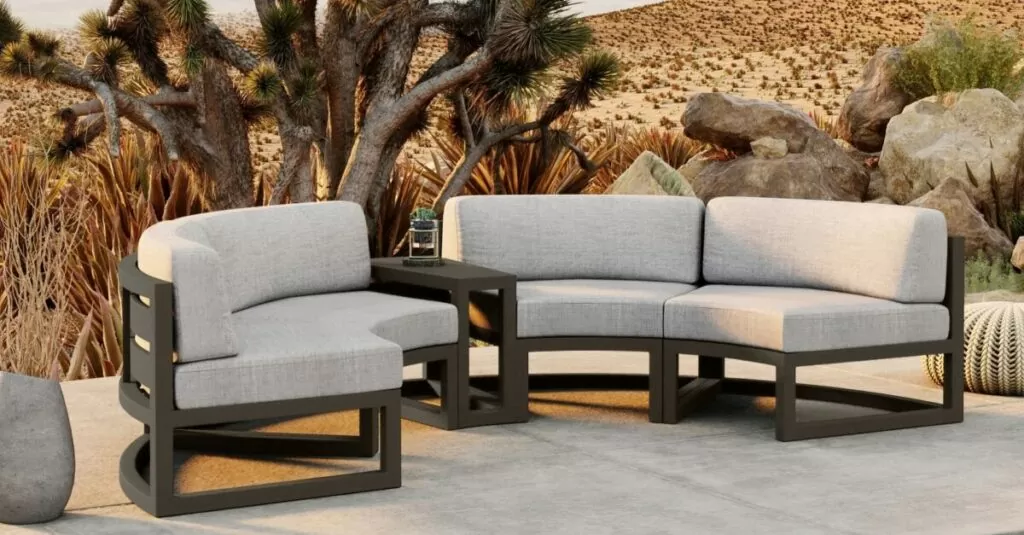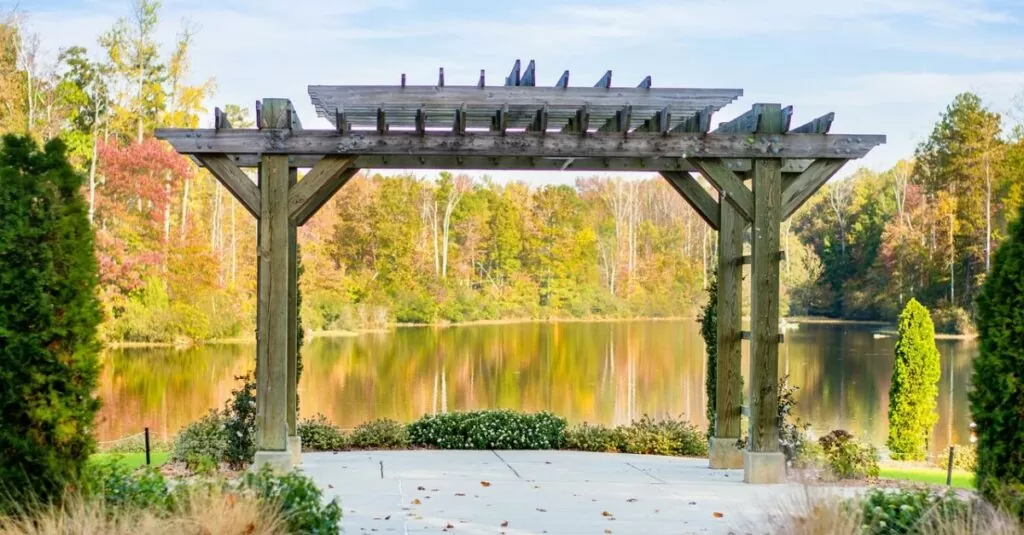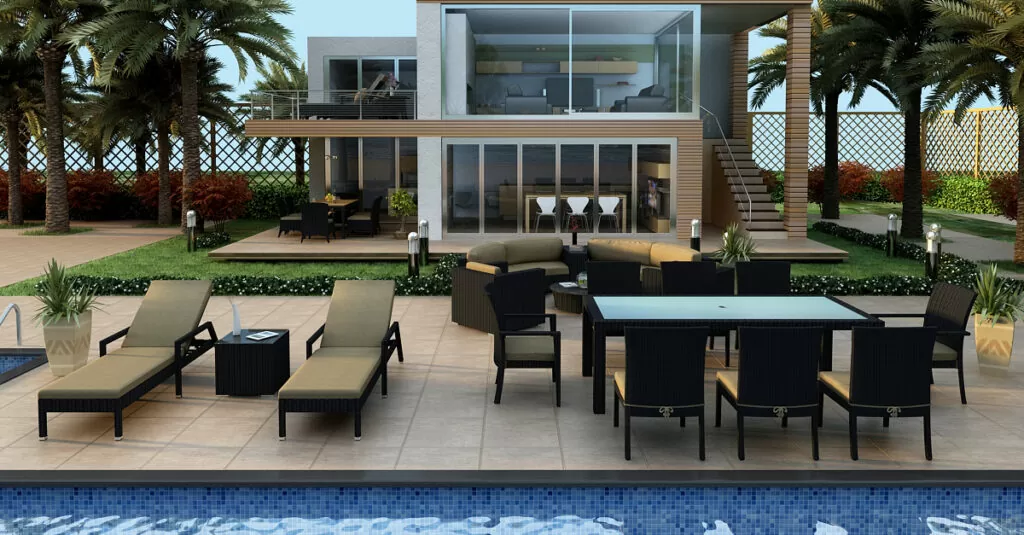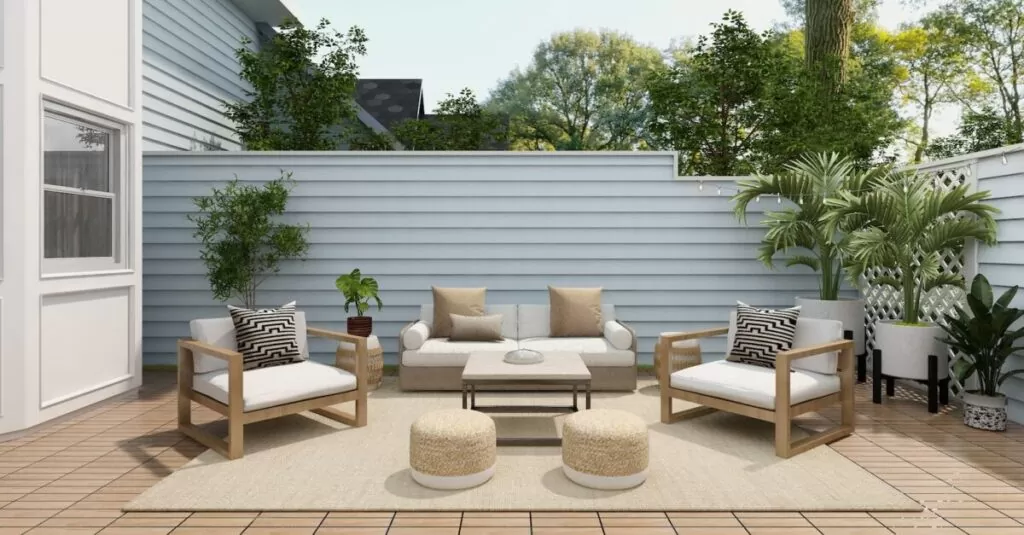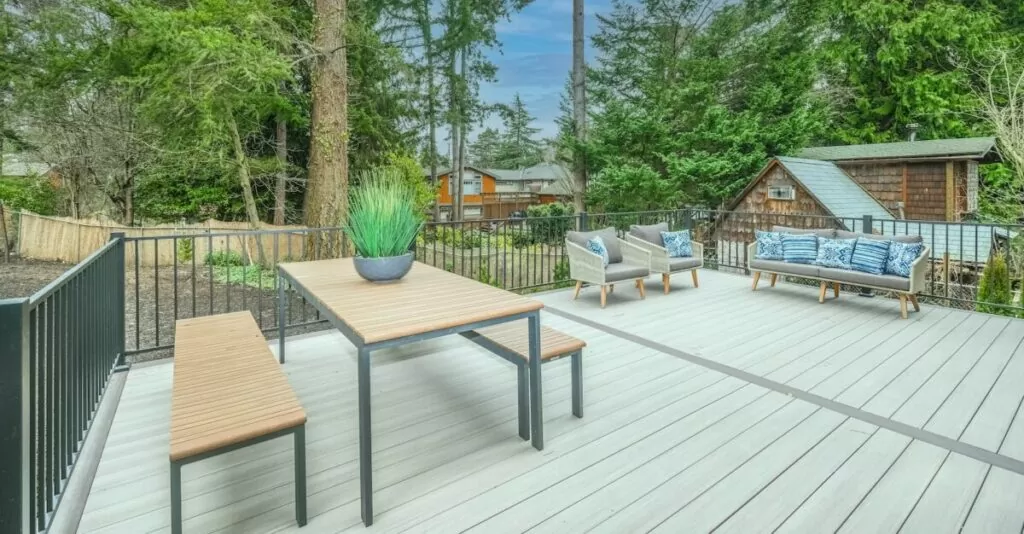Having an outdoor living space that can be used year-round is a dream for many homeowners. There’s nothing better than being able to entertain guests, relax with family, or enjoy a meal outdoors no matter the season or weather. With the right design and features, you can create the perfect covered outdoor living space to use all year long.
Benefits of a Covered Outdoor Living Space
A covered outdoor living space offers many advantages over a typical open patio or deck:
- Protection from the elements: A covered space provides shade from the hot summer sun and shelter from rain and snow. This allows you to comfortably use the space in any weather.
- Temperature control: You can add heating and cooling elements like a fireplace, fans, or portable heaters to regulate the temperature and make the space enjoyable year-round.
- Flexible entertaining: With protection overhead, you don’t have to worry about watching weather forecasts or having backup indoor plans when hosting parties.
- Extended living space: A covered outdoor area seamlessly expands your living space and creates more room for relaxing, cooking, dining and more.
- Increased home value: Upgrading to a covered living space is an investment that can significantly increase your home’s value and set it apart from other properties.

Key Design Considerations
When planning your ideal covered outdoor living space, there are several important factors to consider:
Size and Layout
- Consider existing structures and landscaping when deciding on placement.
- Measure the area where you want to build to determine ideal dimensions. Most experts recommend at least 12 feet deep and 14 feet wide.
- Decide if you want an attached or detached structure based on budget, yard space and local building codes.
- Create designated spaces for different functions like conversation, dining, food preparation, etc.
Climate and Weather
- Review weather patterns in your region – temperature range, seasons, precipitation levels – to choose suitable materials and amenities.
- Incorporate heating, cooling, lighting and protective elements customized for local conditions.
- If in a high humidity area, allow for adequate airflow to prevent mold and mildew.
Purpose and Functionality
- How do you plan to use the space? For lounging, dining, entertaining large groups?
- Include the features and amenities needed for your intended activities – cooking equipment, seating capacity, sound system, etc.
- Consider easy access from indoor living areas for convenience.
- Ensure enough electrical outlets and ports for lighting, appliances, devices.

Ideal Materials and Finishes
Carefully choose materials suited for outdoor use that also complement your home’s existing aesthetic:
- Wood: Cedar, redwood, teak – naturally weather-resistant and add warmth. Need regular sealing/staining.
- Composite: Affordable, durable alternative to wood. Resists moisture, rotting, and insects.
- Aluminum: Lightweight, rust-resistant metal that’s easy to maintain. Can be painted any color.
- Steel: Strong and stable. Requires Galvanization to prevent rusting. Stainless steel is corrosion resistant.
- Concrete: Attractive, textured appearance. Durable but requires sealing to prevent cracks.
- Stone: Elegant natural material. Granite, limestone, and travertine have unique looks.
- Tile: Variety of patterns/colors. Low maintenance but can crack in extreme cold.
- Fabric: Canvas shades/canopies allow visibility while providing cover. Need waterproofing treatment.
- Glass/Acrylic: Clear panels/windows maintain views while keeping out elements. Easy to clean.
Crafting the Perfect Ambience with Lighting
Proper lighting transforms any covered outdoor living space from day to night:
- Task lighting: Illuminate cooking/prep areas, bars, and dining spaces. Use LED or solar options.
- Ambient lighting: Softly light the entire area. Go for energy-efficient outdoor flush mount fixtures.
- Accent lighting: Highlight architectural or design features. Up-lights, down-lights and landscape lighting work beautifully.
- Mood lighting: Set a tone with glowing lanterns, string lights or candles. Increase coziness with fire features.
- Smart controls: Install dimmers, timers, and motion sensors on lighting circuits to easily control ambience and conserve energy.
- Consider resin wicker and weather-resistant fabrics for lamps and other fixtures.

Tips for Furniture and Accessories
Choose outdoor furniture and accessories suited for all-weather use:
- Select materials like teak, aluminum, all-weather wicker, poly-lumber, and synthetic woven rope that withstand the elements.
- Look for UV-resistant fabrics in outdoor cushions, pillows, and rugs. Sunbrella fabrics dry quickly if wet.
- Include weatherproof cabinets, drawers, and storage ottomans to stow away cushions and blankets when not in use.
- Use weighty materials like stone, concrete, or wrought iron for tables, planter pots and sculptures so they don’t blow over in windy conditions.
- Opt for ceramic, melamine, stainless steel or outdoor-rated bamboo in dishes, cups and cutlery.
- Look for exterior-rated TVs, speakers and other A/V equipment if incorporating entertainment systems.
Designing an Outdoor Kitchen
An outdoor kitchen expands your home’s livable space and enables you to cook, dine and entertain outdoors:
- Determine your cooking needs – do you mainly grill or also bake/steam/fry foods? This dictates appliances needed.
- Choose durable surfaces that tolerate weather, food spills and high heat like stainless steel, stone, tile, and high-heat paint.
- Ensure proper ventilation with a vent hood over the grill/stove. Consider installing an outdoor exhaust fan.
- Include ample sealed cabinets and drawers for storage. Stainless steel handles withstand the elements.
- Use an outdoor-rated mini fridge, sink, trash cans and more for full convenience.
- Opt for a built-in or freestanding bar area for prepping food and serving drinks.
- Consider your plumbing and electrical needs based on appliances and lighting. Hire professionals as needed.

Heating and Cooling for Year-Round Comfort
Several heating and cooling options allow you to comfortably use your covered outdoor living space no matter the temperature:
| System | Pros | Cons | Cost |
|---|---|---|---|
| Fireplaces and fire pits | Add immediate ambiance and heat | Require fuel/power source | Gas models: $3,000 – $5,000 <br> Wood-burning: $1,000 – $3,500 |
| Patio heaters | Quickly warm surrounding air | Only heat small area right around unit | Freestanding: $100 – $1,000 |
| Overhead infrared heaters | Efficiently heat people/objects below | Require mounting | $150 – $500 per unit |
| Electric radiant floor heating | Keeps floors toasty underfoot | More expensive to install | $6 – $10 per sq. ft. installed |
| Fans | Circulate air and provide cooling breeze | Only effective at moderate temperatures | Ceiling: $75 – $200 <br> Portable: $30 – $150 |
| Misting systems | Lower air temperature through evaporation | Must replenish water supply | $150 – $500 for kits |
| Retractable awnings/shades | Provide shade and reduce solar heat | Can be pricey for large areas | Cloth: $1,500 – $2,500 <br> Aluminum: $2,500 – $5,000 |
Incorporating Greenery with Landscaping
Strategically placed landscaping helps integrate your covered outdoor living space with the surrounding yard and gardens:
- Use trees, shrubs, vines and plants to delineate the borders of your outdoor room.
- Add planters, pots and window boxes to bring color, texture and life to the space.
- Plant windbreaks like shrubs and trellises to protect your space from harsh winds if needed.
- Incorporate flowering plants that bloom at different times to provide seasonal interest.
- Use evergreen bushes and privacy trees to conceal the area if desired.
- Opt for easy-care native plants suited for local growing conditions. Group plants with similar watering needs.
- Install an automated irrigation system or use soaker hoses to easily water plants.

Caring for Your Outdoor Space
Regular maintenance preserves your covered outdoor living space so it can be enjoyed for years to come:
| Task | Frequency |
|---|---|
| Inspect structure for damage | Annually and after severe weather |
| Re-stain/seal wood elements | Every year |
| Clear drainage systems and gutters | Twice per year |
| Sweep and wash floors | As needed, weekly-monthly |
| Disinfect hard surfaces | Weekly |
| Store fabrics and decor indoors | During winter or long periods of disuse |
| Trim vegetation | Spring and fall |
| Remove debris | Monthly |
| Cover space with tarps | During long periods of disuse |
Estimating the Costs
The cost to build a covered outdoor living space ranges widely based on the size, materials and amenities chosen. On average, expect to invest:
| Type of Space | Average Cost Range |
|---|---|
| Basic 10’ x 12’ covered patio | $5,000 – $12,000 |
| 20’ x 20’ outdoor living space | $15,000 – $30,000 |
| High-end with kitchen, fireplace, spa | $30,000 – $60,000+ |
Factor in these considerations that can impact the budget:
- Type of framing – wood vs aluminum vs steel
- Roofing materials like shingles, metal, polycarbonate
- Flooring – concrete, flagstone, tile, decking
- Luxury kitchen appliances, cabinets, plumbing
- Heating and cooling systems
- Built-in lighting and electronics
- Labor costs if not DIYing
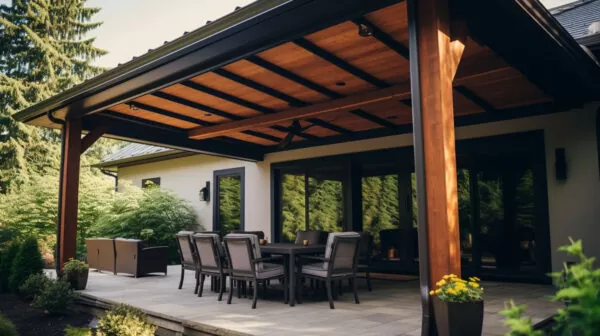
Final Tips for Building Your Dream Outdoor Oasis
- Draw up plans detailing layout, materials, features to guide construction. Consult a landscape architect if needed.
- Research permit requirements in your area for covered structures. Many have size limits or need approval.
- Hire licensed contractors for complex electrical, plumbing and gas work. Do this early before installing finishes.
- Add some DIY touches like decor, cushions and planters to personalize the space.
- Splurge on durable materials even if it costs more upfront, as they last much longer.
With smart planning using the guidance above, you can create the ideal covered outdoor living space to enjoy endless memories with family and friends, rain or shine!

Frequently Asked Questions
What are some good options for roofing materials on a covered patio?
Some popular roofing options include: composite shingles, metal roofing, polycarbonate or fiberglass panels, insulated asphalt, PVC, thermoplastic olefin (TPO), and canvas for retractable canopies. Consider durability, longevity, and noise from rain when choosing.
What kind of flooring works best for outdoor living spaces?
Great flooring choices are concrete, flagstone, pavers, tiles, wood decking, composite decking. Select a slip-resistant material that can withstand the weather and is easy to clean. For colder climates, heated flooring options are also available.
What are essential amenities to include in an outdoor kitchen?
At minimum, an outdoor kitchen should have a grill/oven, sink, cabinets for storage, counterspace for prep, and lighting. Also consider adding a mini fridge, ice maker, wine cooler, pizza oven, kegerator, etc. based on how you’ll use the kitchen.

How much seating should I allow for in my outdoor living space?
As a general rule of thumb, allot seating for each person plus extra:
- Lounging only: 15 sq ft per person
- Lounging and dining: 25 sq ft per person
- Just dining: 10 sq ft per person
For example, for 6 people lounging and dining, allow at least 150 sq ft (6 x 25).
What type of outdoor fabric should I look for?
Choose fabrics specifically designed for outdoor use like polyester, acrylic or olefin that resist fading and mildew. Our prefered fabric is Sunbrella. Avoid cotton, linen, and other indoor fabrics.
How do I control bugs in my covered patio area?
- Use ceiling fans to keep air circulating.
- Install screens on all openings.
- Keep landscape properly watered and trimmed away from the structure.
- Use citronella candles or torches.
- Apply natural insecticides around the perimeter.
- Install bug zappers.

What permits do I need for building an outdoor living space?
Building permits are often required for permanent structures like covered patios and outdoor kitchens. Decks may also need permits. Contact your local permit office to learn about requirements, fees, and processes for obtaining permits before starting construction.
Should I build an attached or detached structure?
Attached structures are often more expensive to build, but provide protection from the elements on all sides. Detached structures are usually more affordable and allow for flexible placement. Check local codes – some places limit detached structures in backyards.

How can I ensure good airflow in a covered patio?
Strategically place windows, doors, and openings to allow cross breezes. Install ceiling fans to keep air circulating. Use sconces or exterior-rated fans instead of enclosed light fixtures. And avoid completely enclosing the area on all sides.
What are some good plants and trees to use around a covered patio?
Choose plants suitable for your climate that add privacy, shade, color and ambiance. Popular options include hydrangeas, ferns, Japanese maples, climbing vines, azaleas, citrus trees, and large leafy plants. Group plants with similar light and water needs.
Video Article Summary:

Todd is a co-owner of Patio Productions and has worked extensively in the furniture industry since 2002, when he started a company that designed and manufactured bathroom vanities. He now has a hand in all online business operations, including keeping tabs on industry trends and making sure Patio Productions remains an innovative leader in the outdoor furniture space. He lives just outside of Denver, Colorado with his wife, two boys, and two dogs. They live on a lake where they can make the most of the outdoor lifestyle. His favorite patio furniture sets are his Harmonia Living sectionals.

